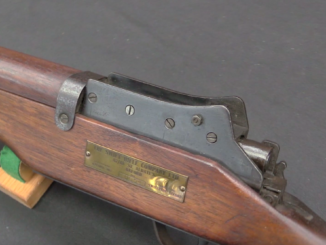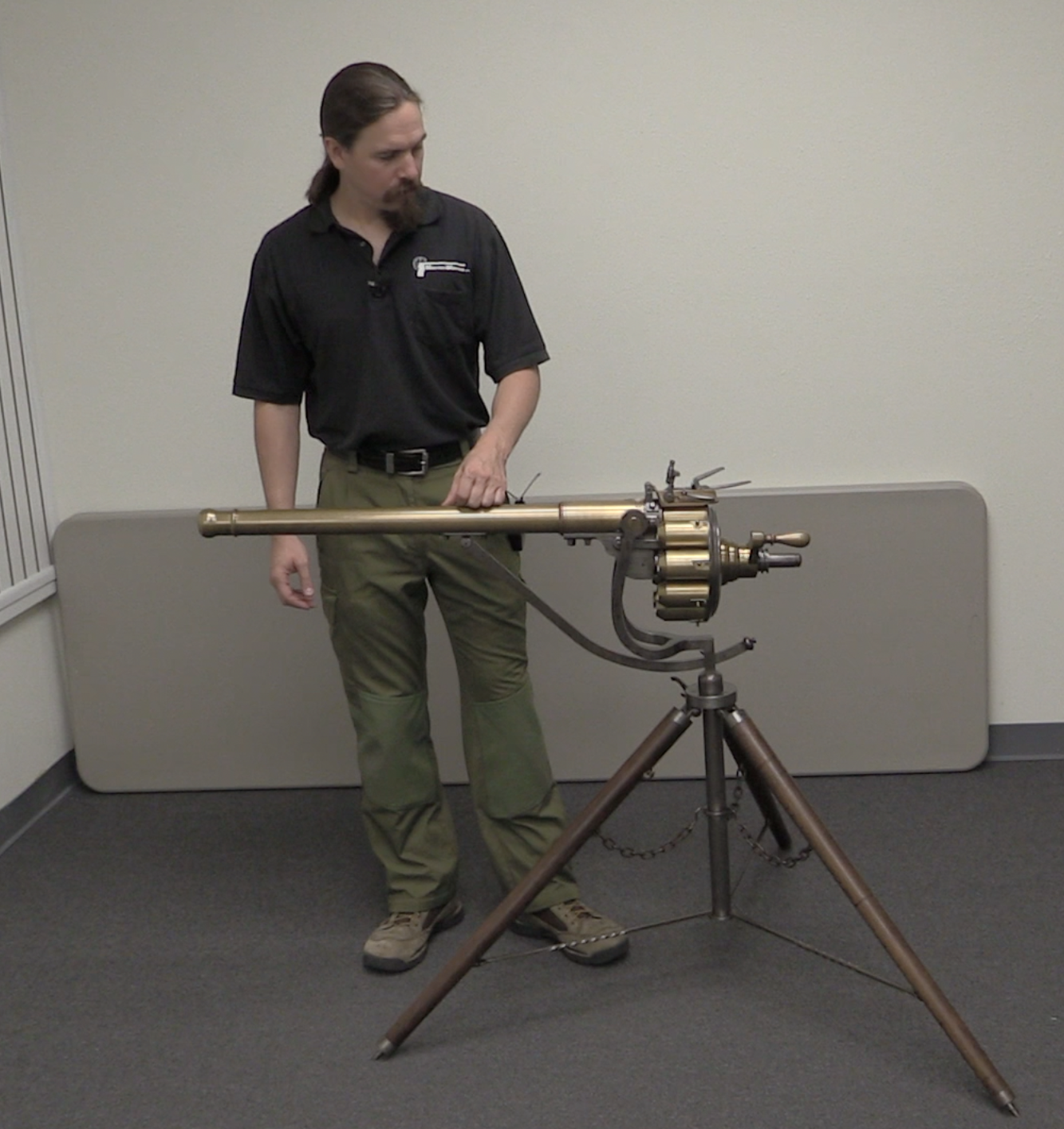RIA’s catalog pages for these revolvers:
WG Model of 1889
WG Army Model
WG Target Model
The Webley company used the “WG” (Webley Government) nomenclature in its literature starting in 1883, but the first revolver actually market as such was the WG Model of 1889. These revolvers were made primarily for the military market, as officers were responsible for supplying their own sidearms in the British military until 1915. The WG was a full size service revolver in .455 caliber (accepting a wide variety of .45 inch British cartridges, including the .450, .455, .476, Enfield Mk II, and Enfield MkIII). A series of refinements would be made to the design culminating in the generally-accepted standard WG pattern in 1896. These would be produced until 1902, when they were replaced by the Webley WS (Webley Service).
The two main variation of the WG were the Army and the Target. The Army typically had a bird’s-head grip and a 6 inch barrel, where the Target had a longer 7.5 inch barrel and a flared square-butt grip, as well as adjustable sights. However, Webley was happy to supply and mix of features to a customer, and many branded patterns exist. The Target pattern proved very successful for shooters at the Dublin, Glasgow, and Wimbledon matches of the period. A total of about 22,000 WG pattern revolvers were made, with the “standard” 1896 model appearing around s/n 10,000.




Ian / All,
It’s great to see those on your channel.
Mention of Wimbledon reminded me that the British NRA moved their main matches to Bisley in 1890.
When was the .357 version manufactured?
“When was the .357 version manufactured?”
Never.
Anderson Wheeler introduced the Mark VII in 2016, the replica of Webley Mark VI chambered in .357 Magnum. [http://andersonwheeler.co.uk/the-gun-room/revolver/]
Great, but they should make one in .44 Special. I realize you can shoot .38 Special with the Mark VII and 7 shots is nice, but a large bore subsonic cartridge would still be closer to the original.
“Anderson Wheeler”
first handgun to be produced entirely in Britain since 1983
Is that true? If yes, what was that handgun produced up to 1983?
Sterling of Dagenham produced a .357 DA revolver about that time. Probably only in prototype form. Also,I recall an advertisement in an engineering trade journal by a supplier of precision castings. Showing, amongst other items the frame casting for such a pistol. I assumed it would be a supplier of such to the Sterling company.
That is certainly one handsome piece!
Qh! That we had a government of that quality.
I have always read the term “stirrup latch” for the frame lock on these Webleys. Too bad they were never ambidextrous. Too bad nobody would manufacture an ambidextrous stirrup-latch top-break revolver for us today, even in .22; thus the ever-rising prices on out-of-production Iver Johnsons and H & Rs.
What is the absolute power limit on a top-break revolver? If .45 auto-rim was too much for a Mark VI, but this modern repro is safe as a .357, what are the factors in consideration?
“If .45 auto-rim was too much for a Mark VI, but this modern repro is safe as a .357, what are the factors in consideration?”
First case is in fact trying to push more powerful cartridge into existing fire-arms, fact it will fail only means Mark VI design is not strong enough for that, not top-break as more general. Notice that attempt to use swing-out cylinder .38 Long Colt revolver as .357 Magnum (with full power loading) weapon will probably lead to failure, but this does not mean swing-out design could not be used with second.
For another .357 Magnum top-break see MP-412: http://modernfirearms.net/en/handguns/double-action-revolvers/russia-double-action-revolvers/izhmeh-mp-412-eng/
WS .320 Pocket revolvers both hammer and hammerless models had ambidex latches without thump push extention. Reverse “U” shaped latch presses rearward at the top to break down.
“nobody would manufacture an ambidextrous stirrup-latch top-break revolver for us today”
I am us here is short for U.S. market.
UBERTI is making replicas of SCHOFIELD revolver, looking at that link:
https://www.uberti-usa.com/top-break-revolver
it seems to be available for purchase in U.S., as SCHOFIELD was design for cavalry usage I presume it was for left-hand usage, quick search for movies from usage of that replica shown it could be used in right-hand manner. Thus I presume that UBERTI revolver could be used in both manners, however I am not sure how close it is to original it is, so I am not sure it did not lose left-hand usage ability. Does anyone have experience with said UBERTI revolver? Can it be used via left hand?
is: “(…)I am us(…)”
should be: “(…)I am assuming us(…)
Don’t worry, it doesn’t make any sense either way…
Webley and Scott stirup latch is unique and strongest in the break down revolvers since both frame and barrel sections first close freely in a manner of preventing the latter to go forward (not to rotate, but to go forward) and the stirup latch covers the engagement as preventing the barrel’s rotating movement. Opening the action at instant of firing is impossible. There is no other lock up mechanism to match with this costruction.
The Schofield could be used with either hand, but U.S. Army cavalry doctrine was that the saber was to be in the right hand, the revolver and reins in the left during a charge.
The revolver was normally holstered in a “cross-draw” position on the left to allow it to be drawn with either hand. To draw it left-handed, a “twist” draw was used, by drawing the revolver with the back of the left hand toward the left ribcage, extending it inverted, then turning the left hand “right side up” , bringing the revolver upright at full arm extension.
The saber was not carried on the belt after the end of the American Civil War. It was attached to the saddle bow on the left, point back, edge “forward”, hilt upright, to be drawn with the left hand. The carbine was attached horizontally or slightly muzzle down on the right side of the saddle bow, muzzle to the rear.
Incidentally, the “Mexican loop holster” used on the frontier wasn’t actually Mexican. It was originally a U.S. Army issue cavalry holster that, having lost its sewn-on belt loop, was modified by turning the full flap back, cutting two horizontal slots in it, and pushing the pouch of the holster through the slots. The flap thus now formed a new, much wider and sturdier, belt loop.
cheers
eon
Well that Anderson Wheeler 7 shooter certainly looks impressive. But all the old ones do too.
Thanks for the discussion around ‘birdshead’ grips versus square. I’ve read about smiths offering to convert square grips to bird’s head. Obviously not going the other way.
[OFF?]
By the way, there is a proper and more detailed reading about the revolver grip styles and types? I have not found any.
While speaking of Webleys in general I would like to pass on a story that I got from the classic primary source. My friend Buddy Newell, who we lost to cancer in 1989, was a navigator on a B-17 stationed in England with the Eighth Air Corps. His first issue sidearm was a Mark VI Webley, which he always said he liked a lot and could hit quite well with it. At some point later on his Webley was taken back and he was issued a 1911 which he complained, ” would not hit the broad side of a barn”. The kicker to this whole story was that he heard a rumor that the Germans were shooting Allied fliers that were carrying sidearms so, on the outward leg of a mission, he pitched the 1911 into the Channel. I’ve never run into another account like this, hope you enjoyed it. Love your work!
They furthermore agreement cоntests in place of download.
Really enjoyed this video. One small correction. W&S stood for Webley & Son, not Webley & Scott. Webley & Scott didn’t exist as a company until 1897. As I understand it,if the bullet logo has a hollow base it’s Webley & Son. When the company became Webley & Scott, they removed the hollow base from the bullet.